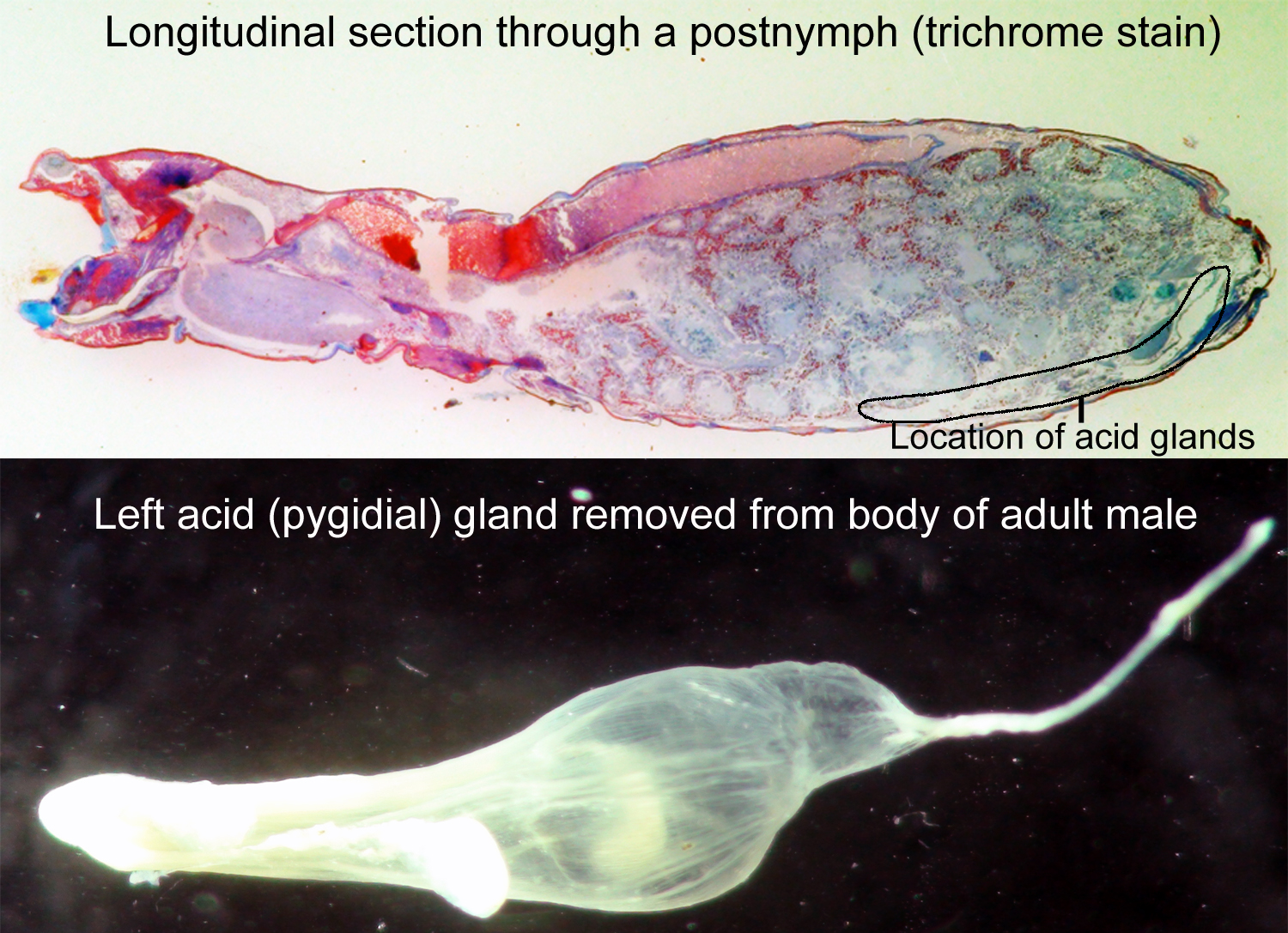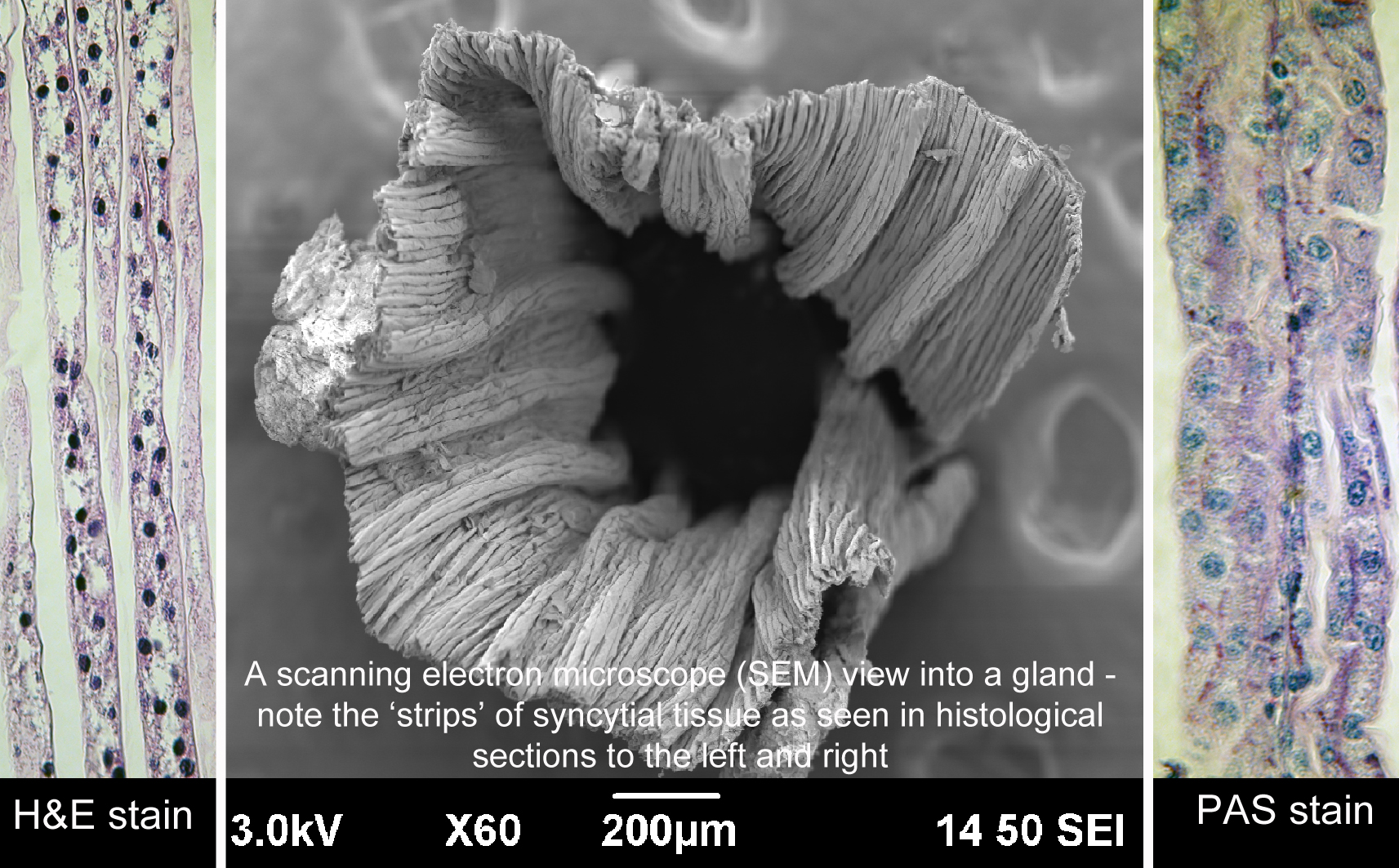About This Project
Whip scorpions (vinegaroons) such as the North American species Mastigoproctus giganteus - an unusual arachnid of the pet trade – spray acids at would-be attackers using a pair of pygidial glands. The recipe of this acid cocktail includes a variety of different compounds, but to date, the genetic, biochemical, and cellular bases for acid production remain a mystery. Here, we propose to investigate the genes and pathways in the pygidial glands that lead to this unique form of defense.
Ask the Scientists
Join The DiscussionWhat is the context of this research?
Whip scorpions are the only known arachnids to rely on the secretion and spraying of acids for defense. The identity of these acids continues to receive attention, but little is known about the glands that produce them or the genetic and biochemical basis of acid production. We recently began exploring these topics by first describing the structure of the pygidial glands. But even as we accumulate novel data about gland characteristics, we realize that a more complete picture of their function and evolution can only be had through an identification of the genes that are turned on and off (aka transcription) during secretion. So, in this project, we propose to generate the first transcriptome of a vinegaroon and identify which genes play a role in acid secretion in the pygidial glands.
What is the significance of this project?
All animals produce acids to aid in digestion, but few species make acids that function in defense. Using transcriptomics, we propose to generate gene expression profiles for the vinegaroon pygidial glands and compared them to their gut tissue to answer 3 questions: Do gland profiles match those of their gut tissue, which makes acids for digestion? Can transcriptomics provide insight into the development and evolutionary origins of the glands? Do expression profiles of the glands match those of other arthropods that also make acids for self defense (e.g., formicid ants)? Answers to these questions will provide novel and exciting insights into the history of whip scorpions and provide clues about how unique organ systems such as the pygidial glands evolved in this unusual arachnid lineage.
What are the goals of the project?
The goal of this research is to generate the first transcriptomic profile of whip scorpion pygidial glands as a basis for answering questions about their biochemistry and evolution. We know that different species produce different acid cocktails, but we know nothing about how they do it, why they do it, or how the glands evolved to generate different acids. Once we have sequenced M. giganteus, we can compare its transcriptome to other acid-producing arthropods (e.g., formicine ants) and begin sequencing other whip scorpions for comparison. This data will also help us and others to produce expression profiles of related animals that may have defensive glands but are difficult to work with due to their tiny size and cryptic nature (e.g., short-tailed whip scorpions and microwhip scorpions).
Budget
We are requesting funds for the construction of two types of transcriptomes (i.e., gene expression/RNA-Seq libraries) - one for whip scorpion acid glands and another for their digestive tissues. The digestive tissues will serve as experimental controls for comparison to the glands. Two libraries of each tissue type are the minimum needed to perform statistical analyses that would identify genes with biased expression in each tissue type. Each library costs $575 to construct at the Univ. of Massachusetts Medical School, which is our lowest cost provider. We also require funding to sequence these four libraries on one lane of an Illumina HiSeq 2000 instrument, which costs $2750. With these funds, we hope to gather enough preliminary data to answer questions about the functions and origins of the glands. We also look forward to using this data to apply for a larger grant on the Arachnida and answer broader questions about the biology and evolution of whip scorpions and their relatives.
Endorsed by
Meet the Team
Team Bio
Our team consists of Dr. Rick Hochberg and Dr. Jessica Garb, both of whom are Associate Professors of Biology at the University of Massachusetts Lowell. We have taught together (Biology and Evolution of Arthropods), presented together (USA Science and Engineering Fair), advised MS and PhD students together, and even have adjoining labs, which makes collaborations easy and fun. We are committed to the field of invertebrate zoology and have capitalized on different skill sets to advance the field.
Rick Hochberg
I am an invertebrate zoologist that traditionally works on obscure aquatic invertebrates such as gastrotrichs and rotifers. I got involved with whip scorpions quite by accident. I occasionally team teach a course with Dr. Garb entitled, Arthropod Biology and Evolution, and like to have lots of live specimens for the laboratory portion of the course (e.g, scorpions, pseudoscorpions, tarantulas, crabs, insects). I ordered a few live vinegaroons for the class and was immediately intrigued. I began breeding them and now have several pregnant mothers and lots of subadults (1st-3rd instars). With so many animals available, we began exploring different aspects of their anatomy that are not well known, such as the chemistry of their exoskeleton and the structure of their defensive glands. So far, my graduate students and I have performed analyses of the vinegaroon exoskeleton using energy dispersive x-ray spectroscopy (EDS) to reveal the presence of heavy metals (manuscript in preparation; see related publication below), and we are currently examining the structure of their acid (pygidial) glands using classical histology, confocal microscopy, and scanning and transmission electron microscopy. I also work alongside professor and arachnologist Dr. Jessica Garb who is well versed in arachnid genomics and transcriptomics, and together, we have created a partnership that blends traditional morphological techniques with current advances in molecular biology.
Related Publication:
Gallant, J., Ada, E., & Hochberg, R. 2016. Elemental characterization of the cuticle in the marine intertidal pseudoscorpion, Halobisium occidentale Beier, 1931. Invertebrate Biology 135:127-137.
Jessica Garb
My field of expertise is in the biochemical characterization of spider silk and venom proteins, and linking variation and evolution of these fascinating molecules to the amazing diversification of spiders. My lab utilizes techniques of genomics, bioinformatics, gene expression and evolutionary biology to understand the chemical ecology of arachnids.
Additional Information
.jpg)

 These images were taken mostly by my Master's student John Freeman, whose thesis is focused on the histology of the pygidial glands. The images are of the pygidial gland reservoirs, which are not the actual secretory units of the glands.
These images were taken mostly by my Master's student John Freeman, whose thesis is focused on the histology of the pygidial glands. The images are of the pygidial gland reservoirs, which are not the actual secretory units of the glands. Project Backers
- 52Backers
- 105%Funded
- $5,125Total Donations
- $98.56Average Donation




